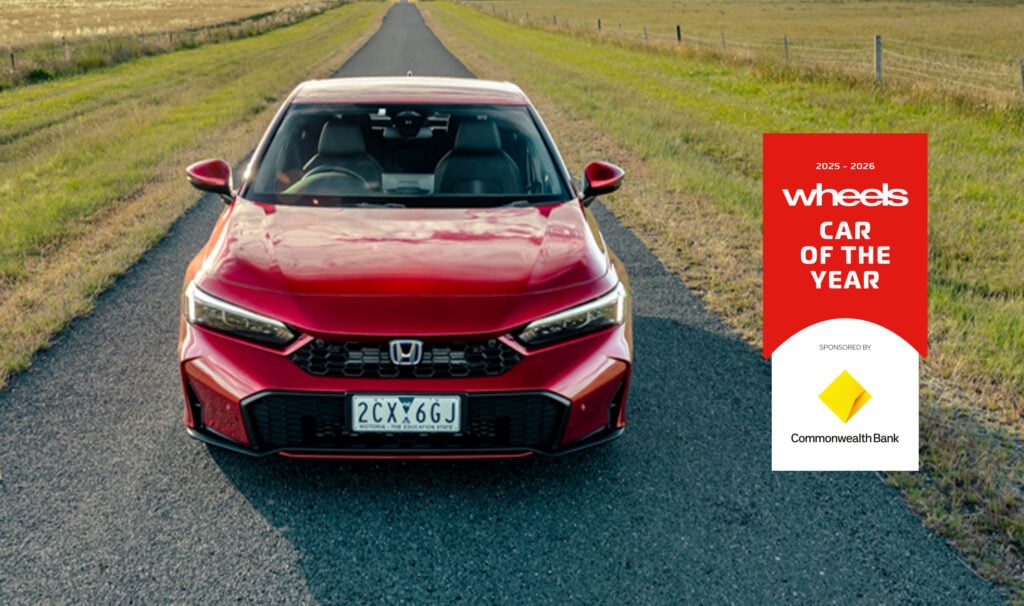A stellar year for new cars is set to make sparks fly among the judging panel.
THERE have been some lacklustre COTY fields over the years – headlined by 2000’s startlingly drab Toyota RAV4, Volvo V70, Chrysler PT Cruiser and Subaru ‘Bug Eye’ Impreza finalists – but the Class of 2016 is about as far removed from that nadir year as Trump is from a thick set of locks. Indeed, it’s hard to think of a more high-achieving automotive year than the past 12 months.
We saw completely fresh, standard-setting metal right across the board, from Holden’s transformed Spark micro-hatch to the revived Honda NSX supercar, its intriguingly complex powertrain and drive system reminding the world that “Honda is Back!”
But what do we think has the best chance of taking out the most coveted award in Australian motoring – the Wheels 2017 Car of the Year?

Demonstrating just how broad the design and engineering excellence is at Ingolstadt these days, we’ll also have the second-generation Audi R8 on hand to fly the flag for naturally aspirated supercars. There’s been worthwhile and consistent improvement across the board with this car, most obviously in its stunning interior, but how will the R8’s blend of wild sex appeal and Germanic sense fare in the face of the tech-heavy Honda NSX, with its envelope-pushing drivetrain and intensive air-flow management?

Jump ahead two classes and there’s a full suite of small-car contenders preparing for an unprecedented battle royale. From the miracles-can-happen tenth-gen Honda Civic to the crucial Holden BK Astra, the totally refreshed new-gen Subaru Impreza, the Hyundai AD Elantra (precursor to next year’s all-new i30), and the technology-laden Renault Megane IV, the small-car class has never seen so much talent hit so hard, so fast.

There will be other inevitable inter-comparisons going on in this year’s 28-strong field.


Alongside the Korean-built Renault, we’ll have another respected nameplate from South Korea – the Kia Sportage. It may share its name with some pretty dire predecessors, but the latest generation is a comparative revelation, mixing European styling with genuine dynamic panache. But can its carryover engines cut the mustard alongside the force of its turbo-petrol compatriots?

Representing the ‘quirky’ category is the marvellously left-field Citroen C4 Cactus, which we know offers a miraculous blend of seating comfort, cabin space and fuel efficiency. But will the ageing diesel – which accounts for 80 percent of sales – be crucified by its robotised-manual gearbox, countering the turbo-petrol’s velvety charm? And will completely unexpected handling talent and driver reward be enough to elevate the chances of the unusually styled Toyota Prius, given that its once-radical mechanicals and interior design are now par for the course?

Another COTY contender that’s emerged from a date with a turkey-baster and a rival manufacturer (in this case, Mercedes-Benz) is the Infiniti Q30 hatch, and its slightly raised QX30 all-wheel-drive sibling. Born from Benz’s MFA platform, and sharing drivetrains and some switchgear with the A-Class and GLA, the Q30 twins hail from Nissan’s UK plant. Yet there’s much goodness to be had in their quality dynamics, strong performance and individual style. Can the Q30/QX30 go one better than the A-Class by moving beyond Round One?

Similarly super-sized but competing in a completely different category is the Skoda Superb large liftback-sedan and wagon. For the same money as a VW Passat, this Czech relative underpins its buyer-appeal with bahnstorming performance from a pair of 2.0-litre turbo-petrol powerplants, not to mention Audi quattro-rivalling dynamics from the range-topping 4×4.

Yep, it’s the stunning new Volvo S90 up against the brand-defining W213 Mercedes-Benz E-Class and the impressive second-generation Jaguar XF. In the S90’s corner reside the expected suite of safety and construction excellence, fabulous seating and interior, and the unbelievable effectiveness of Volvo’s 2.0-litre four-cylinder engines in such a large car. But the E-Class is no duffer in the safety department, and matches the top-spec S90 Inscription’s terrific all-wheel-drive system with a superb ‘4matic’ system of its own (a first for right-hand-drive Australia).

And if we feel like an antidote to four-pot diesel efficiency, the Ford Mustang and Mercedes-Benz C-Class Coupe/Cabriolet are guaranteed to deliver, especially in their range-topping V8 guises. Of course the C-Class is also available as a diesel, but it’s the just-launched all-wheel-drive, twin-turbo V6 C43 AMG and the incredible twin-turbo V8 C63 AMG that will flesh out the COTY-criteria capabilities of this elegant new Mercedes-Benz two-door.

But being a great buy – or a great drive, or a great design, or having benchmark efficiency, quality or technology – isn’t going to be enough to win the
2017 Wheels Car of the Year award. In a field this strong, only the absolute cherry on the cream covering the icing of a multi-layered cake will succeed.





